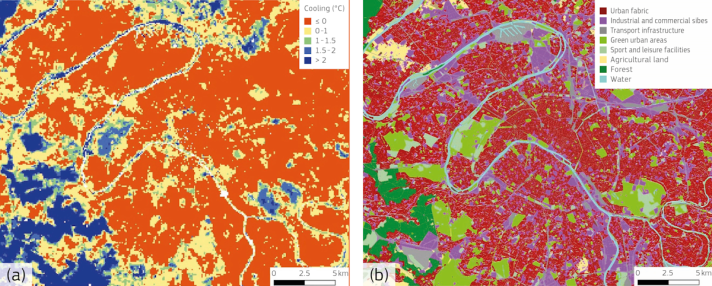
Heatwaves are amongst the most severe effects of climate change, and record-breaking temperatures are becoming ever more frequent and intense. Built-up urban areas and cities are particularly vulnerable to extreme heat: this phenomenon affects over 1.7 billion people around the world. Nearly half of the roughly 10 000 cities in the world have faced increased heat exposure over the last 4 decades. A new JRC policy brief gives an overview of strategies, best practices, and policy tools to help local authorities in EU cities to manage extreme heat.
Heat extremes and urban heat islands
Heatwaves are prolonged periods of extremely high temperatures that can lead to urban overheating and to urban heat islands (UHI). This UHI effect alters the surface of cities, making them significantly hotter than surrounding suburban and rural areas – on average 4-6 degrees hotter, and with peaks up to 10 degrees above neighbouring areas.
But why are our cities becoming so hot?
Urban areas have many features that increase heat. For example, in cities there are more sealed surfaces like roads, and buildings which absorb heat during the day and release it at night. There is also a higher density of people and infrastructure like public transport systems that emit heat. This is compounded by low ventilation, and fewer green spaces and waterways, which can all help reduce temperatures.
The consequences of extreme heat are not only uncomfortable but also dangerous. Aside from unbearable temperatures which can cause dehydration, heat-stroke and other short term physical effects, UHI effects also trap pollution, which reduces air quality and leads to longer term health risks. These disproportionately affect vulnerable and marginalised groups: lower-income, unemployed and homeless people, as well as children, older people, and those affected by chronic conditions. They also lead to increased energy demand, increasing cities’ ecological footprint.
How can we fight extreme heat?
This JRC policy brief encourages policymakers to combine mitigation and adaptation actions – reducing greenhouse gas emissions while increasing resilience to heat extremes. Many of these actions are being taken up by cities as part of the Global Covenant of Mayors for Climate & Energy.
The Spanish city of Murcia for example won the Covenant of Mayors spotlight award for their actions to tackle urban overheating. These included resurfacing dark asphalt roads with lighter coloured materials to reflect rather than absorb sunlight, significantly reducing surface temperatures.
This simple action with a big impact was just one of 61 measures the city took to adapt to extreme heat. With this policy brief, the JRC identifies best to help inform local authorities of steps they can take to tackle urban heat. For example:
- Integrating and enhancing green infrastructure such as promoting green walls and roofs, and increasing the number of trees and vegetated surfaces. Trees and green spaces have an outstanding capacity to cool the air in cities: according to a study on more than 600 European cities, urban trees reduce air temperature by 0.8 degrees on average, with peaks
- Introducing water features and flowing water in public areas, and providing drinking water to the population, along with making water use more efficient.
- Retrofitting and renovation of buildings with insulation and shutters, as well as using reflective materials, such as white paint, on streets and buildings.
- Promoting urban farming.
- Providing timely healthcare measures, for instance warning systems to guide the population during extreme heat events, or displaying the location of shelters and drinking water points.
- Inspiring examples of best practices include a network of pilot schools in Barcelona transformed into cooling shelters, open to the public during heatwaves; and the adoption of nature-based solutions in Turin.
A complete overview of the key findings on extreme heat in EU cities, strategic recommendations and monitoring tools is available in the Policy Brief: EU cities and heat extremes.
Effective place-based policies and actions require a deeper understanding of temperature variations and their urban distribution. Each city is unique and urban adaptation plans must consider their own space and geography to target high-exposure areas and vulnerable neighbourhoods effectively.
Positive impact on society
This research helps local, regional and national authorities to develop practical and cost-effective policies to better manage extreme heat as global average temperatures rise. Working with partners like the Covenant of Mayors to implement these policies, the JRC is helping to improve quality of life for the benefit of society as a whole.
Background
EU cities and heat extremes is part of a series of policy briefs on the Future of Cities, presented through dedicated webinars.
Watch recordings of previous sessions and sign up for future webinars.
The Future of Cities report illustrates the main challenges our cities will have to face, and the strengths they can capitalise on to build their desired futures.
The Global Covenant of Mayors for Climate & Energy initiative, built on the EU Covenant of Mayors launched in 2008 has been designed to provide local governments, in highly diversified national contexts, with a framework for their local energy and climate actions, many of which draw on knowledge generated by the JRC.
Details
- Publication date
- 22 July 2024
- Author
- Joint Research Centre
- JRC portfolios





